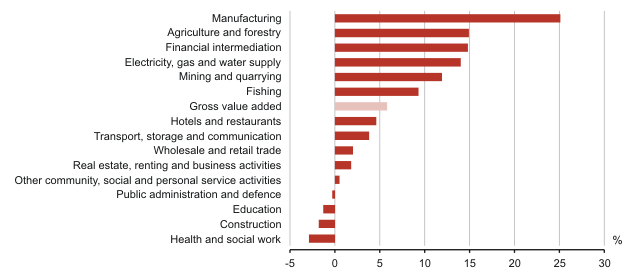Vigorous exports in manufacturing contributed to the economic growth in the 3rd quarter
The seasonally and working-day adjusted GDP increased by 0.7% in the 3rd quarter compared to the 2nd quarter. Compared to the previous quarter, the GDP increased for the fourth quarter in succession. In the 2nd quarter this year the GDP increased by 1.9% and in the 1st quarter 1.0%.
In the 3rd quarter, the GDP at current prices was 58.8 billion kroons (3.76 billion euros).
The GDP of the 3rd quarter was above all influenced by the growth of value added (25%) in the manufacturing activity produced due to a vigorous growth of exports. The sales of manufacturing production on the domestic market increased as well. The sales of manufacturing production on the domestic market increased last in the 1st quarter of 2008. The increase of the value added produced by manufacturing of electronic and optical equipment accounted for the largest share in the growth of manufacturing. The increase of the value added produced by manufacturing of wood and wood products, as well as by manufacturing of basic metals and fabricated metal products also had a remarkable impact on the growth of manufacturing. The contribution of manufacturing to the GDP growth was 3.1 percentage points, which is over 60%.
The value added of the economic activities in the primary sector, industrial sector and predominantly market-based service sector increased. In the industrial sector, only the value added produced in construction decreased (2%). At the same time, the decrease of the value added of construction activity decelerated steeply due to the increase in construction volumes abroad and in construction volumes in local structures. The value added of the economic activities of the predominantly non-market service sector, i.e. those activities which belong to the general government and non-profit institutions serving household sector, decreased continuously.
Despite the growth of the domestic demand (5%), its share in the GDP decreased, accounting for 87% in the 3rd quarter. Thus, domestic final consumption expenditures, gross capital formation and changes in inventories were smaller than produced value added. Domestic demand grew primarily due to the increase in changes in inventories. Increase of the inventories of goods and raw materials of the non-financial corporations had the biggest impact on the increase in changes in inventories.
Household final consumption expenditures grew by 1%, but its effect on the growth of the domestic demand was small. The growth of the household final consumption expenditures was caused mainly by the increase in expenditures on durable goods, especially on vehicles and household goods and furnishing. At the same time household final consumption expenditures were inhibited by the decrease in expenditures on food, non-alcoholic and alcoholic beverages and tobacco. Household final consumption expenditures grew last in the 4th quarter 2007.
Gross fixed capital formation decreased by a tenth. By assets, investments in buildings and structures decreased the most. At the same time, investments in machinery and equipment increased to some extent. Gross fixed capital formation has decreased since the 3rd quarter of 2007. While the share of the gross fixed capital formation in the GDP was 35% in 2007, it has decreased to merely 18% by the 3rd quarter this year.
Exports of goods and services grew in real terms 24% in the 3rd quarter in support of the improvement of the external demand. Exports of goods increased by 36%. The growth was influenced mainly by the growth of exports of radio, television and communication equipment, as well as by the increase in exports of wood and wood products, metals and machinery and equipment. Enlivening of economy and increase in domestic demand brought along a rapid growth of imports. Imports of goods and services increased by 29%, including imports of goods by a third. The growth of imports of goods was influenced mainly by the growth of imports of radio, television and communication equipment. Growth in imports of motor vehicles, building materials and chemical raw materials also had a big impact on the increase of imports. Exports of goods and services have exceeded imports since the 1st quarter of the previous year. The share of net exports in the GDP was 9% in the 3rd quarter of the current year.
Change of the value added of the economic activities by chain-linked method compared to the same period of the previous year, 3rd quarter 2010
As usual, the primary income (compensation of employees and investment income) payable to the rest of the world was bigger than the primary income received from the rest of the world in the 3rd quarter. Therefore, the Gross National Income (GNI) was smaller than the GDP (56.1 billion kroons or 3.58 billion euros). In the 3rd quarter the gross disposable income increased faster than final consumption expenditures, so the gross saving of the total economy increased. Gross saving accounted for 31% of the gross disposable income, which is the highest result since 1995. Gross saving is a substantial domestic source for financing capital investments. As the saving of the total economy exceeded gross capital formation in the 3rd quarter, Estonia was net lender for the rest of the world. Net lending accounted for 9% of the gross disposable income. Estonia has been net lender for the rest of the world since the 1st quarter of the previous year.
Primary sector consists of agriculture, hunting, forestry and fishing.
Industrial sector consists of manufacturing, mining and quarrying, electricity, gas and water supply and construction.
Predominantly market services sector consists of wholesale and retail trade, hotels and restaurants, transport, storage and communication, financial intermediation, real estate, renting and business activities, other community, social and personal service activities.
Predominantly non-market services sector consists of public administration and defence, education, health and social work.
